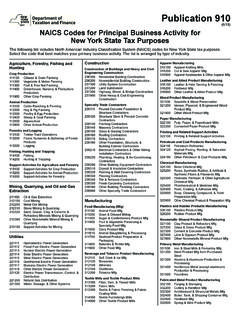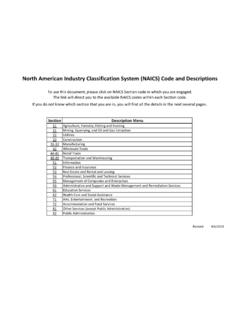Transcription of Guide to Cereals in the UK - AHDB Cereals & Oilseeds
1 Guide to Cereals in the UK. Guide to Cereals in the UK. WHEAT. Wheat is the most widely grown arable crop in the UK. On average, it covers around 2 million hectares of land and produces about 15 million tonnes of wheat each year with over million tonnes exported to countries mostly in the EU. Wheat is a versatile crop and is used mainly for milling into flour for bread and biscuits, and for animal feed. The UK has two classifications of wheat for exports; ukp (bread wheat) and uks (soft wheat). ukp and uks exist to create strong, consistent and recognisable classifications to help you easily identify UK milling wheat.
2 2. Guide to Cereals in the UK. ukp comprises of semi-hard wheat varieties which are suitable to both EU and non-EU bread making. Overseas importers like the consistency and versatility of ukp and it is suitable for many products and can be used to blend with other wheat. The table below highlights ukp wheat specifications: Specific weight (kg/hl) 76 (min). Ad mix (%) 2 (max). Hagberg Falling Number (s) 250 (min). Protein (%) 11-13. W 170 (min). P/L (max). Wet Gluten 5 year harvest quality data ukp 2009/10 2010/11 2011/12 2012/13 2013/14. Specific Weight (kg/hl) Hagberg Falling Number 295 307 318 257 341.
3 Protein (%) W 207 217 199 201 220. P/L Wet Gluten 3. Guide to Cereals in the UK. uks is soft milling wheat suitable for biscuit making, as it has low protein, high extensibility and low water absorption. The low protein level makes it easy to use across a range of biscuit making recipes, including wafers. The table below highlights uks wheat specifications: Specific weight (kg/hl) 75 (min). Ad mix (%) 2 (max). Hagberg Falling Number (s) 220 (min). Protein (%) W 70-120. P/L (max). Wet Gluten 5 year harvest quality data uks 2009/10 2010/11 2011/12 2012/13 2013/14.
4 Specific Weight (kg/hl) Hagberg Falling Number (s) 217 224 268 222 279. Protein (%) W 78 78 92 82 82. P/L Wet Gluten 4. Guide to Cereals in the UK. FEED WHEAT. Wheat produced in the UK which does not meet the high specification required for domestic or overseas milling is generally classed as feed wheat.'. Feed wheat is used in a range of animal feed rations for all classes of livestock. Benefits of feed wheat in animal feed rations: n Provides a source of energy due to its high starch content and makes a good substitute for corn in the ration n Has a higher protein content than corn, reducing the need for protein supplementation in the ration n Suits a variety of processes - can be fed whole, ground, rolled, flaked or pelleted n Reduces the need for a pellet binder due to higher gluten content.
5 Cereal Quality Survey Results hard endosperm, non-milling wheats GB Feed Wheat 2010 2011 2012 2013 Average 2010-13. Specific weight kg/hl Hagberg Falling Number (s) 223 230 221 228 Protein (%) UK feed wheat is generally sold as minimum and maximum 15% moisture. 5. Guide to Cereals in the UK. BARLEY. UK barley is grown for human consumption, malting, brewing or distilling and for animal feed. It is an important crop in the rotation system on many farms. In the UK, the production of barley in 2013/14. reached 7Mt with over going for exports. It is the second most widely grown crop in the UK; and is currently exported to 26 countries.
6 4 year harvest quality data GB Barley 2010 2011 2012 2013 Average 2010-13. Specific weight (kg/hl) Nitrogen content (%) Grain through sieve (%) Grain retained by sieve (%) 6. Guide to Cereals in the UK. MALTING BARLEY. UK malting barley is grown for malt distilled from grain to make a range of products from breakfast Cereals to high quality alcoholic drinks such as beer and whiskey. Malt is gaining popularity in the food industry as a flavouring component and a source of nutrients. The UK regularly exports malting barley to key buyers including major beer producers such as Germany and the Netherlands.
7 Good quality malting barley depends on nitrogen content and its ability to germinate; both attributes are found in UK malting barley, which has undergone rigorous testing by the industry. 7. Guide to Cereals in the UK. FEED BARLEY. Barley is a major cereal component in animal feed rations (including fish) and is well recognised as an excellent energy source for ruminants, providing high levels of starch. Being a hard grain it cannot be fed whole, however, it suits a range of processing techniques such as rolling and flaking. In the United States, barley is a valuable grain for finishing beef diets, whereas in Europe it is widely used in pig and poultry diets.
8 Its starch content is slightly lower than wheat and corn but its protein content is similar to wheat and higher than corn making it a useful substitute for corn. The UK regularly exports feed barley to key buyers such as Saudi Arabia and other Middle East and North African countries. 8. Guide to Cereals in the UK. OATS. On average, 700,000 tonnes of oats are produced every year for human and animal consumption. Oats are used in breakfast Cereals , beauty products and animal feed. Over 35,000 tonnes has been exported from the 2013/2014 season, mostly to the EU.
9 Oats are widely grown in regions with cooler temperatures, primarily for the human food breakfast market but it is still a valuable energy source for farm livestock and horses. 9. Guide to Cereals in the UK. OILSEED RAPE. Over recent years, oilseed rape production in the UK. has taken on a greater prominence, with increases in both area and total production. Last year, 720,000. tonnes was exported to seven counties in the EU. The seed is crushed to extract oil, which is used in the food and animal feed industries, with the residue being used as a high protein animal feed ingredient.
10 There has also been a strong demand for rapeseed oil for use in biodiesel production in Europe. 10. Guide to Cereals in the UK. OTHER PRODUCTS. The UK also produces smaller quantities of other Cereals and Oilseeds : n Triticale n Linseed n Rye As well as processed and co-products: n Malt n Co-products of ethanol production n Co-products of the milling process 11. Guide to Cereals in the UK. QUALITY ASSURANCE JOURNEY. These quality assurance and traceability processes and measures have been put in place by industry and government to ensure UK Cereals are of the highest possible quality and safety.






